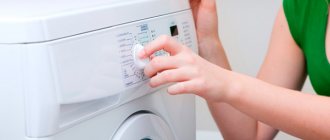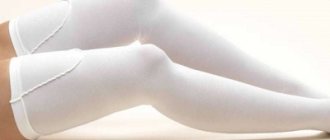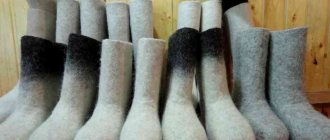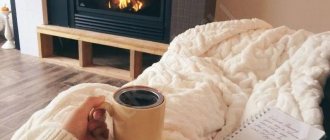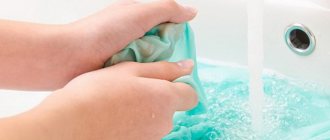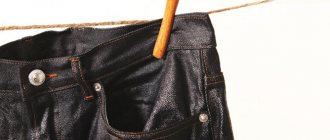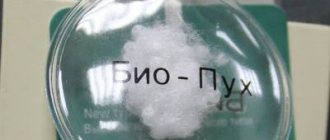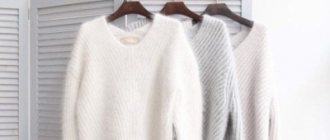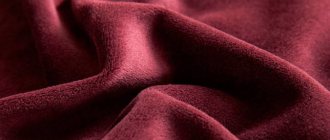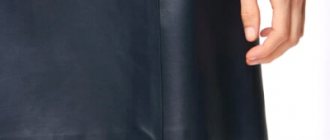Natural fabrics are highly environmentally friendly, they are comfortable, practical, and back in fashion.
With proper care, this material has a long service life, becoming softer and more pleasant over time. The question arises - how to wash linen so as not to spoil it?
In this article we will tell you whether and how to properly wash linen in a washing machine and by hand, and at what degrees linen items should be washed.
Is it possible and at what temperature?
When preparing things for washing, you should decide whether to process them by hand or in the washing machine. It is advisable to start by studying the label for the product. The manufacturer indicates all the care features on it.
When caring for linen, hand washing is the best treatment option. But to save time and effort, you can use a washing machine.
In the washing machine
Before putting an item into the drum of the machine, it is necessary to inspect the product . If necessary, carry out minor repairs and remove stains. The detergent must be selected taking into account the color of the material.
For white fabrics, you need a special preparation designed specifically for things of that color. For blacks there is also a separate remedy. All other linen items are washed with universal powders and gels aimed at colored items.
Procedure:
Place items in the drum.- Set the mode to “delicate”.
- Set the temperature according to the manufacturer's recommendations. Usually it is from +30ºС to +40ºС. Otherwise, things may shrink and fade.
- The spin is set to a minimum - from 400 to 500 rpm. If you neglect this rule, the product may become severely wrinkled.
- Set up an additional rinse.
- Start the wash cycle.
Manually
If you have the opportunity to wash linen items by hand, you should take advantage of it. In this case, washing will be as gentle as possible. It is necessary to prepare a large basin in advance. If it is not available, you can wash it directly in the bath.
Work order:
- Fill a large container with warm water (up to +40ºС).
- Dilute the detergent (powder or gel).
- Dip the item into the soap solution.
- If the item is dirty, you can soap it and leave it soaked for 15-30 minutes
- Wash.
- Rinse, changing the water.
Smooth out wrinkles without removing the fabric
Owners of steam generators or hand-held steamers can use these household appliances to care for curtains.
Steam treatment is carried out without removing the canvas. The material is cleaned of dust, straightened, and the curtains take on a fresh, well-groomed appearance. The treatment is carried out from top to bottom, the fabric is carefully pulled back and straightened.
Not all curtains can be ironed without removing them. This method of care is unacceptable for very thin and delicate tulles . Therefore, you must first make sure whether the steam generator can be used for this fabric.
In addition, you need to carefully observe the temperature regime so that hot steam does not melt the fabric fibers and damage the product.
Video on how to clean curtains without removing them:
How to remove stains correctly?
The appearance of stains on clothes during wear or on home textiles is not a rare thing. The use of store-bought stain removers and folk recipes will help solve the problem.
It should be borne in mind that stains from flax are very difficult to remove. Many old stains are almost impossible to remove.
The sooner you start removing the stain, the higher the chance of removing it completely.
Fat
The following recipe will help
you deal with greasy stains on linen clothes or tablecloths
- pour 0.2 l into a bowl. cold water;
- pour in 1 tsp. ammonia;
- using a sponge or small sponge, treat stains with wiping and blotting movements;
- after the greasy trace has disappeared, rinse the item in water;
- wash in the usual way.
The following recipe is also suitable for removing fat from flax
- Mix 5 tbsp in a container. l. ammonia, 1 tbsp. l. dishwashing liquid and 1 tbsp. l. alcohol
- Mix.
- Apply the product to the stain with a sponge.
- Leave to sit for 10 minutes.
- Rub.
- Rinse off.
- Wash.
Red wine
Stained clothing or home textiles can be cleaned of traces of red wine. If you get down to business right away, the majority of the pigment can simply be washed off with a stream of water.
The following actions:
- the stain is covered with salt;
- leave for 10 minutes;
- washed off.
For white fabric, you can use non-chlorine bleach.
Ball pen
In order to remove the mark of a ballpoint pen from the material, you can use ordinary laundry soap . The area of fabric is moistened, soaped and rubbed.
If you tackle stain removal right away, the chance of success increases significantly.
Ammonia will also help in this case . But this method is better suited for white linen. A cotton swab is moistened with alcohol and the mark from the pen is treated. After this, the item is washed.
Blood, urine
If the stain on linen is old, it will not be possible to remove it completely. Hydrogen peroxide applied directly from the bottle to the affected area can help with a fresh mark. After the chemical reaction is over, the item is rinsed in cold water and washed.
This method will help deal with stains on white fabric, but with colored ones, you need to be careful, as peroxide can eat away bright colors.
For colored matter, the following recipe may be useful:
- Beat 1 raw yolk into a bowl.
- Add 1 tsp. glycerin.
- Mix.
- Apply with a sponge to the fabric.
- Leave for 2 hours.
- Rinse off with plenty of water.
- Wash.
Coffee
To remove coffee stains, you can use a recipe based on ammonia and glycerin.
Procedure:
- Dilute ammonia (1 tsp) and glycerin (1 tbsp) in 50 grams of water;
- after all the components are mixed, the mixture is carefully applied to the stain with a sponge or cotton swab;
- leave for 10 minutes and wash off;
- the item is completely erased.
Fabric bleaching
Bleaching of linen fabrics is used quite often. It is important not to use products with chlorine. This chemical is detrimental to linen; it destroys the fibers of the fabric, accelerating the wear of the material and leading to the deterioration of the entire thing.
White linen can be bleached with oxygen-containing laundry detergents or using folk recipes.
Ammonia
A simple recipe will help remove yellowness from fabric:
- Pour non-hot water (3 liters) into a container.
- Add detergent.
- Pour in 3 tbsp. l. ammonia.
- Soak the item for 3 hours.
- Wash.
- Rinse.
Hydrogen peroxide
The soaking solution is prepared based on the proportion:
- 3 l. water;
- 9 tbsp. l. peroxide.
To achieve results, you need to soak things for a long time. From 12 hours to 24 hours. After this, the textiles are washed in the usual way.
Turpentine
One of the bleaching substances is turpentine, add 2 tbsp. l. onto a basin of soapy water . Soak the item in the prepared solution for 8 hours. After this, the product needs to be washed.
Selecting a detergent
- Unpainted items can be washed with regular chlorine-free powder or laundry soap. Chlorine can damage the fiber structure and turn a durable and wear-resistant item into a brittle one.
- On undyed fabrics, non-chlorine bleaches, such as oxygen bleaches, can be used. They have a gentle effect on the fibers without destroying their structure.
- You can also add water softeners, balms, and fabric softeners.
Useful
It is better to wash colored items made of linen fabric with special liquid detergents, powder for washing colored and children's underwear. Thin and loose fabrics can only be washed by hand in warm water.
Do new linen items need washing?
New items that have just been purchased and have never been used can and should be washed.
This will remove any remaining dye and chemicals used to treat fabrics . In the process of manufacturing flax products, their packaging, transportation and sale, many people come into contact with them.
Before introducing a new item into use, it is recommended to wash it. This is especially important for clothing, baby items, bedding and cutlery.
Some manufacturers subject linen products to pre-treatment before going on sale, after which the item will no longer shrink.
How to dry and iron?
The best option for drying linen products is to hang them in the fresh air. If you do this at home, you should choose a dry room with good air access.
Linen bed linen, towels and napkins are dried by throwing them over a rope, shirts and blouses - on trempels, trousers and skirts - on hangers with special clips.
When hanging things, you need to straighten them and give them the required shape . This must be done immediately, since flax itself dries quickly.
Ironing begins when the material is not yet completely dry. Dried clothes will be much more difficult to iron. When ironing, the fabric can be moistened and steam can be used.
After such treatment, things should be left to lie on a horizontal plane, giving them time to completely dry and cool. Only completely dry items can be stored.
Can Roman blinds be washed?
Before washing Roman blinds, the fabric is removed, since vertical cleaning can lead to warping of the material. To avoid damage to the fabric during machine washing, a special bag is used. Then it is advisable not to wring out the curtains at all - the water should drain naturally. The canvas is installed on the structure while still wet. Thanks to this, the slats are inserted into the appropriate places and the shape of the curtain does not change.
If the fabric is made of velvet/velor, then it is strictly forbidden to hang the curtains in a damp/wet state. First, the fabric must be completely dry (we recommend drying it on a horizontal surface using a terry cloth backing).
Recommendations
The following tips will help you cope with washing linen
- Due to its high absorbency, washing linen requires a lot of water.
- If you use a machine for washing, it is recommended not to load it completely. This will allow things to wash better.
- Before washing linen items, it is necessary to sort them, separating white and colored items.
After washing, linen needs a good rinsing. When washing automatically, this is achieved by setting an additional rinse; when washing manually, by changing the water several times.- A slight shrinkage after washing is natural for linen items, the material of which does not contain synthetic fibers.
If the treatment was carried out correctly, then when worn or ironed, linen clothing will return to its shape. The lower the percentage of synthetics in the fabric, the more shrinkage it can give. - After washing, you should not twist things; it is better to allow the water to drain freely.
- Pre-soaking items improves the quality of washing. After it, the item can be washed either by hand or in a machine.
- Washing linen is easier in soft water than in hard water.
- If you doubt the safety of a fabric stain remover, you should first test it on an inconspicuous area.
If linen fabric has embroidery, the item should not be soaked.
You will find maximum useful information about washing clothes and various fabric products here.
Properties of flax
Linen is valued for its excellent hygienic properties, strength, naturalness and environmental friendliness, hypoallergenicity, ability to kill bacteria and regulate temperature. Clothing made from linen is very comfortable: it quickly absorbs excess moisture and dries, allows the body to breathe, and does not become electrified.
It is thanks to all these advantages that flax is used for the production of men's, women's and children's clothing, bedding, and home textiles.
But there are also disadvantages - 100% natural fabric can wrinkle, stretch, fade and shrink when washed.
Read about: how to wash tulle so that it is white.
Nowadays linen fabrics undergo special processing, which adds elasticity to the fibers and allows the product not to wrinkle. For the same purpose, synthetic fibers are added to the fabric during production. The likelihood of finished products shrinking is very low, since before production the material is usually specially washed and dried, after which it does not shrink again. Therefore, it is important to choose quality items.
On a note
And yet, even such durable fabric can deteriorate, lose its attractiveness and some positive qualities. Aggressive detergents, chlorine bleaches, rubbing and twisting are all things to avoid.
